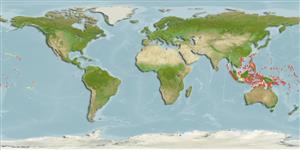Environment: milieu / climate zone / depth range / distribution range
экология
морской ассоциированный с рифами; немигрирующий; пределы глубины 0 - 30 m (Ref. 13227). Tropical; 30°N - 15°S
Western Pacific: Japan (Ref. 76833), Ryukyu Islands to eastern Australia, including Mariana, Marshall, Samoan, and Phoenix islands (Kiribati), the Ouvéa Atoll in the Loyalty Islands, to American Samoa.
Size / Вес / Возраст
Maturity: Lm ? range ? - ? cm
Max length : 4.8 cm SL самец/пол неопределен; (Ref. 54980)
колючие лучи спинного плавника (общее число): 15 - 16; членистые (мягкие) лучи спинного плавника (общее число): 9-10; колючие лучи анального плавника 1; членистые (мягкие) лучи анального плавника: 17 - 19. Males have dark lower head and are abruptly dark posterior, occasionally with alternating broad dark and light bands (Ref. 37816 ). Adults are identified by the greenish tail and the color usually extends well onto the body (Ref. 48636). Mature males with two broad, black bands below third dorsal fin base and caudal peduncle, two bands joined ventrally; posterior half of anal fin black in mature males; caudal fin base white; pectoral and pelvic fins and body orange in mature males (Ref. 76833).
Adults are found in various reef habitats (Ref. 48636) especially in reef flats and tidepools (Ref. 90102) and in surf-swept reef margins. Also found in intertidal areas and is usually associated with coralline rock and coral reef lagoons (Ref. 13227). Eggs are hemispherical and covered with numerous sticky threads that anchor them in the algae on the nesting sites (Ref. 240). Larvae are planktonic which occur primarily in shallow, nearshore waters (Ref. 94114).
Life cycle and mating behavior
половая зрелость | размножение | нерест | икра | Fecundity | личинки
Fricke, R., 1994. Tripterygiid fishes of Australia, New Zealand and the southwest Pacific Ocean (Teleostei). Theses Zool. 24:1-585. (Ref. 13227)
Статус Красного Списка МСОП (Ref. 130435)
Угроза для людей
Harmless
Использование человеком
рыболовство: интереса не представляет
дополнительная информация
ссылкиаквакультура (рыбоводство)особенности рыбоводствастепень растяжениягенетикаElectrophoresesнаследуемостьболезниобработкаNutrientsMass conversion
соавторыизображенияStamps, Coins Misc.звукиCiguateraскоростьтип плаванияжаберная областьOtolithsмозгзрение
инструменты
Специальные отчеты
Скачать в формате XML
ресурсы в Интернет
Estimates based on models
Preferred temperature (Ref.
123201): 27.1 - 29.3, mean 28.7 °C (based on 1529 cells).
Phylogenetic diversity index (Ref.
82804): PD
50 = 0.5000 [Uniqueness, from 0.5 = low to 2.0 = high].
Bayesian length-weight: a=0.00562 (0.00258 - 0.01228), b=3.08 (2.89 - 3.27), in cm total length, based on LWR estimates for this (Sub)family-body shape (Ref.
93245).
Trophic level (Ref.
69278): 3.2 ±0.3 se; based on size and trophs of closest relatives
устойчивость к внешним воздействиям (Ref.
120179): высокий, минимальное время удвоения популяции до 15 месяцев (Preliminary K or Fecundity.).
Fishing Vulnerability (Ref.
59153): Low vulnerability (10 of 100).
Nutrients (Ref.
124155): Calcium = 325 [145, 881] mg/100g; Iron = 1.68 [0.74, 3.29] mg/100g; Protein = 18.2 [16.8, 19.6] %; Omega3 = 0.106 [0.039, 0.307] g/100g; Selenium = 50.5 [14.1, 154.8] μg/100g; VitaminA = 61.8 [13.2, 287.7] μg/100g; Zinc = 3.85 [2.04, 6.37] mg/100g (wet weight);
